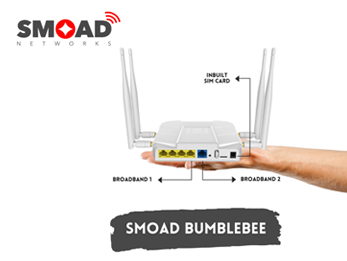
Difference between your home router and SMOAD SD-WAN router
The overwhelming amount of data and the instant requirement to retrieve specific information drives modern businesses. With offices moving to the cloud, storing and retrieving data has become simple. Traditional home routers are being replaced by SD-WAN routers, due to their cloud-friendly feature. To know why people are moving away from home routers to virtual WAN architecture, we need to first understand the functions of both routers.
Home routers are the most common network device that connects your local home network with the internet. There are both wired and wireless home routers that facilitate connecting of multiple devices to the internet. Traditional routers facilitate the distribution of control functions across the device in a network. It routes traffic based on the TCP/IP address, ACL, basic firewall and limited QoS features. Home routers are not cloud and enterprise-friendly. They usually are a low specification router hardware and complex to configure and fix, resulting in poor user experience (such as router hang or poor network performance) and regular downtimes.
SD-WAN routers are cloud-friendly and provide superior Quality of Experience (QoEx) for the users. Depending on your business needs you can set QoS and security policy enforcement. Enterprises are moving to Software-as-a-Service (SaaS), where businesses access applications on the cloud and not from a server(s) deployed in the data center. Virtual WAN architecture facilitates a combination of communication services like MPLS, LTE and broadband to connect users to applications securely. SD-WAN routers are designed to support applications hosted on-premises, public or private clouds, data centers and SaaS services with the highest performance levels.



Difference between a generic router and an SD-WAN router
Limited memory configuration: Home routers have a limited CPU and memory configuration, which can lead to limited QoS and Firewall performance resulting in packet loss, or router freeze. On the contrary, in SD-WAN routers there is more than adequate CPU and memory configuration, which can provide superior overall device performance. Thus, minimizing or eliminating packet loss and device freeze.
Limited lifespan: Traditional routers are made of a plastic body that does not sustain heat dissipation, thereby reducing the overall performance of the router. As a result, the router freezes or reboots frequently. In the case of SD-WAN, the router is made of metal and it can withstand operating temperature effectively. Therefore, no reboots or freeze in the network, ensuring a longer life for the router.
Aggregation of connectivity: Downtime is frequent with home routers as it comes with one WAN port and no LTE or 4G option. While an SD-WAN router has multiple WAN ports along with LTE/4G options, ensuring your connectivity is up and running all the time with features such as aggregation and failover.
IoT friendly: The Internet of things (IoT) connects internet-enabled
devices to cloud-based applications to transmit information outward and inward.
Home routers are not IoT-friendly since they often lack basic features and, in some cases, hardware support too. SD-WAN routers monitor the network for IoT applications, to scale, secure and optimize bandwidth utilization. Mission-critical IoT applications are supported efficiently by Edge SD-WAN architecture to optimize and secure applications. Enterprises can improve operations by installing IoT applications at the network edge for optimum data transmission on wired, wireless, 4G or 5G infrastructure.
SMOAD range and its uses: Forget about running individual network connections to integrate your business. SMOAD devices are the one-stop solution for all your network connectivity requirements. With SMOAD routers you can connect with your branch office, home office, transport vehicles or IoT devices in a single WAN and all this at an affordable price and foolproof security.
SMOAD edge routers help you and your business stay connected with the state-of-the-art SD-WAN technology. It comes with multiple SIM card options, 2 broadbands, 2 WAN ports and Wi-Fi coverage of up to 50 meters. SMOAD SD-WAN routers are pre-configured to suit your need and ready to connect straight out of the box.

